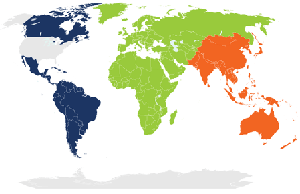Friday, January 31, 2025
The ICAO and International Training staff is based in Washington, D.C. and Montreal, Canada, and is responsible for managing the overall FAA relationship with the International Civil Aviation Organization (ICAO) and other global organizations involved in or affecting U.S. aviation interests. In addition, the staff lead many of the coordination and implementation of aviation activities that have a global impact.
The United States is a founding member of the International Civil Aviation Organization, which was established in 1944 by the Chicago Convention on International Civil Aviation. Currently, there are 193 members or contracting states in ICAO, which is governed by the ICAO Council, which is composed of 36 member states including the United States. Headquartered in Montreal, Canada, ICAO's core function is to develop and support the implementation of global standards and recommended practices for international aviation. These include safety, security, and air traffic management, among others. ICAO supports the implementation of these standards through technical assistance programs, and monitors their implementation through the Universal Safety Oversight Audit Program (USOAP).
The United States Mission to ICAO is led by a U.S. ambassador appointed by the President of the United States and is headquartered in Montreal. The Ambassador is assisted by a Deputy Chief of Mission (DCM) from the U.S. Department of State, as well as by a Senior Representative of the FAA, who is a member of the ICAO and International Training staff. In addition, the United States appoints an Air Navigation Commissioner to serve as an independent technical advisor on the Air Navigation Commission (ANC). The ANC is the principal body concerned with the development of all international air navigation and safety standards and procedures covering international civil aviation. The Ambassador represents the United States on the ICAO Council, and the DCM, FAA Senior Representative, and Air Navigation Commissioner serve as alternate Council representatives.
The ICAO and International Training staff manage the FAA's relationship with ICAO headquarters, and ensures agency-wide coordination of technical aviation positions at ICAO that advance U.S. safety objectives. The ICAO and International Training staff lead the ongoing coordination effort across United States Government (USG) in the planning and execution of major events such as the triennial ICAO Assembly Sessions, the High-Level Safety Conference, Air Navigation Conferences, and other major ICAO events.
Recognized globally for its commitment to safety, the FAA helps the world's aviation community keep safety first in order to build and maintain the flying public's trust. ICAO and International Training staff do that in part through their extensive outreach and aviation training programs for foreign Civil Aviation Authorities, Air Navigation Service Providers, Regional Safety Oversight Organizations, and others.
Additionally, they ensure that training and outreach events are aligned with the FAA international strategy and priorities and modernize training offerings to meet international stakeholder needs and reflect Agency priorities in the rapidly shifting aviation landscape. Working together, they ensure that the international aviation network provides the maximum safety and benefits for the traveling public and the citizens of the world.
To request a training or workshop event and ask further questions, please email AviationTraining@FAA.gov.
The Office of International Affairs also plays a key role by managing the Interagency Group on International Aviation (IGIA). IGIA was created in 1960 to provide coordinated, inter-agency recommendations on aviation matters to the U.S. Department of State. IGIA membership is comprised of representatives from the U.S. Departments of Transportation, State, Commerce, Homeland Security and Defense, as well as the National Transportation Safety Board and the Federal Communications Commission, with additional USG agencies included as necessary. The Assistant Secretary for Aviation and International Affairs at the Department of Transportation serves as the IGIA Chairperson, and the Executive Director of the Office of International Affairs is the Vice Chairperson. The ICAO and International Training staff provide administrative support as the IGIA Secretariat.
The IGIA Secretariat includes a Principal Staff Officer who is responsible for coordinating USG aviation positions with the applicable IGIA member agencies. In addition to coordination of broad cross-USG international aviation matters, the IGIA Secretariat serves as the conduit between the USG and ICAO headquarters and ICAO's seven regional offices. All incoming documentation or correspondence for USG information or action is directed to the IGIA Secretariat for coordination and the IGIA Secretariat is responsible for the submission of responses to the appropriate organizations and ICAO Offices.

